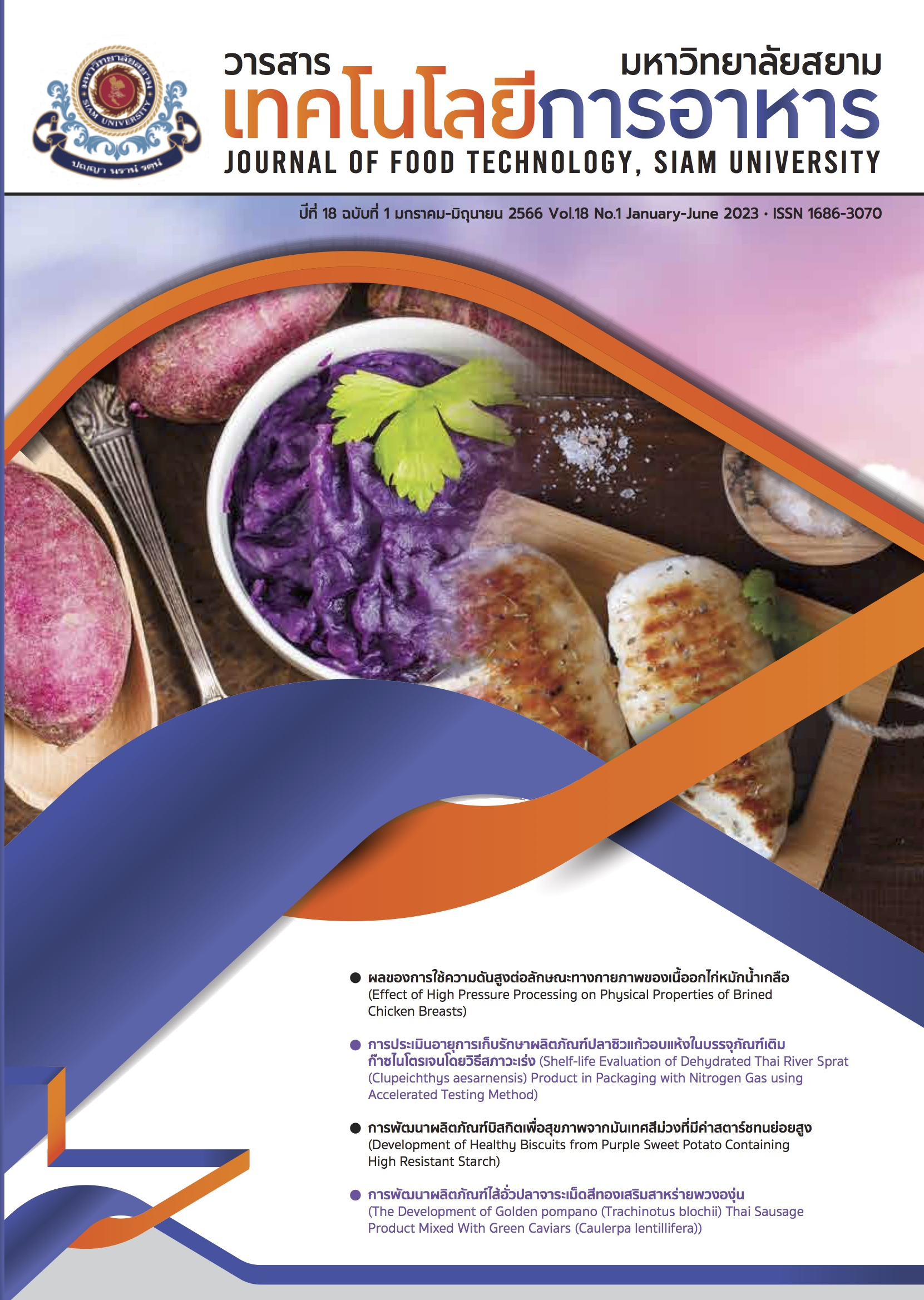The Development of Golden pompano (Trachinotus blochii) Thai Sausage Product Mixed with Green Caviars (Caulerpa lentillifera)
Main Article Content
Abstract
This experimental research aimed to develop Thai Sausage made from Golden Pompano mixed with Green Caviar. The experiment consisted of three major stages: 1) to explore the quantity ratios of Golden Pompano per pork during the production process: 80:20, 90:10, and 100:0 (based on the weights). According to ten experts, using 100 percent of Golden Pompano per weight obtained the highest overall satisfaction scores. Therefore, this recipe was being selected to mix with Green Caviar. 2) The sausage from previous process was brought to mixed with 0.1, 0.5 and 1.0 percent of Green Caviar respectively. According to the experts, the sausage with 1.0 percent of Green Caviar received the highest satisfaction scores, especially in terms of texture and flavors. 3) The chemical quality, microbiological quality, and nutritional values of the product were experimented. The results showed that the microorganisms occurred during the second week was equivalent to 2.6X104 colonies per 1 gram of sample. Furthermore, the amounts of yeast found in this product was 1.3x103 colonies per 1 gram, which defined that the product’s shelf-life is 2 weeks, if it is stored in a closed container at room temperature. In terms of nutrition, the product was found packed with protein, carbohydrate, fiber, beta-carotene, and essential fatty acids such as palmitoleic, oleic, and linoleic acid.
Article Details

This work is licensed under a Creative Commons Attribution-NonCommercial-NoDerivatives 4.0 International License.
Copyrights of all articles in the Journal of Food Technology available in print or online are owned by Siam University and protected by law.
References
Sachi, S. (2008). Principle of product development and sensory evaluation. Phitsanulok: Faculty of Agriculture, Naresuan University.
Fuller, G.W. (1994). New product development from concept to marketplace. CRC Press, Inc., Boca Raton, FL, USA.
West, C.K., Farmer, J.A. and Woff, P.M. (1991). Instructional design. implication from cognitive science. Allyn & Bacon, Boston.
Katz, F. (1998). How major core competencies affect development of hot new product. Food Technology. 52(12): 46 - 52.
Bailly, N. (2011). Snubnose pompano, Trachinotus blochii. [Online] Available from http://fishbase.sinica.edu.tw/Summary/speciesSummary.php [Accessed April 29, 2020].
Department of Fisheries. (2019). Cultivation and processing of sea grapes. Phetchaburi Coastal Fisheries Research and Development Center, Phetchaburi.
Nguyen, V.T., Ueng, J.P. and Tsai, G.J. (2011). Proximate composition, total phenolic content, and antioxidant activity of Seagrape (Caulerpa lentillifera). Journal of Food Science. 76(7): C950-C958.
Ito, K. and Hori, K. (1989). Seaweed: chemical composition and potential food uses. Food Reviews International. 5(1): 101–144.
BAM. (2001). Bacteriological analytical manual online. Food and Drug Administration: Silver Spring, MD.
ISO. (2017). ISO 6579-1: 2017. Microbiology of the food chain – Horizontal method for the detection, enumeration and serotyping of Salmonella- Part 1: Detection of Salmonella spp. Geneva Switzerland.
BAM. (2016). Bacteriological analytical manual online. Food and Drug Administration: Silver Spring, MD.
AOAC. (1984). Official methods of analysis. (14th ed.). Association of Official Analytical Chemists. Washington D.C.
AOAC. (2006). Official methods of analysis. (18th ed.). Association of Official Analytical Chemists. Gaithersburgs, MD.
AOAC. (2016). Official methods of analysis. Association of Official Analytical Chemists. Washington D.C.
AOAC. (2019). Official methods of analysis of AOAC international. (21st ed.). Gaithersburg, Maryland.
AOAC. (2012). Official method of analysis. (19th ed.). Association of Official Analytical Chemists. Washington D.C.
Williams, L.J. and Abdi, H. (2010). Fisher’s Least Significant Difference (LSD) Test. In N. Salkind. (ed.), Encyclopedia of Research Design. (pp.154). Sage, Thousand Oaks.
Penwipha, T. (2021). Seaweed value more than deliciousness. Academic Journal of Department of Science Service. 64(200): 26 - 27. http://lib3.dss.go.th/fulltext/ dss_j/2559_64_200_P-26-27.pdf
Ratana, P. and Chirapart, A. (2006). Nutritional evaluation of tropical green seaweeds Caulera lentillifera and Ulva reticulate. Kasetsart Journal (Natural Science). 40(1): 75-83.
Elmadfa, I., Fritzsche, D. and Cremer, H.D. (1995). Die grosse GU Vitamin and Mineralstoff. Tabelle. Graefd and Unzer.
Nopparat, M., Donrudee, P. and Uraiwan, W. (2018). Quality change post-harvest management of Caulerpa lentillifera (research report). Rajamangala University of Technology Srivijaya, Songkhla.
Grovenor, M.B. (2002). Nutrition from Science to Life. Harcourt Inc., US.
Insel, P., Turner, R.E. and Ross, D. (2002). Nutrition. Jones and Bartlett Publishers, Massachusetts.
Sumontha, W. (2006). Textbook of food microbiology. Chamchuri Products, Bangkok.
Suthiphan, D. and Rossukon W. (2019). The study of suitable shiitake sausage recipe and shelf life. Academic Journal of Science and Applied Science. 2019(1):71 - 82. https://ajsas.uru.ac.th/files_complete/ 1591349368_8488.pdf
Thai Industrial Standards Institute. (2006). Thai Fish Sausages Community Product Standards. [Online] Available from https://tcps.tisi.go.th/pub/tcps1225_49.pdf [Accessed December 15, 2022].
Rubio, B., Martinez, B., Dolores García-Cachán, M., Rovira, J. and Jaime, I. (2008). Effect of the packaging method and the storage time on lipid oxidation and colour stability on dry fermented sausage salchichón manufactured with raw material with a high level of mono and polyunsaturated fatty acids. Meat Science. 80: 1182-1187.
Ansorena, D. and Astiasaran, I. (2004). Effect of storage and packaging on fatty acid composition and oxidation in dry fermented sausages made with added olive oil and antioxidants. Meat Science. 67: 237-244.


